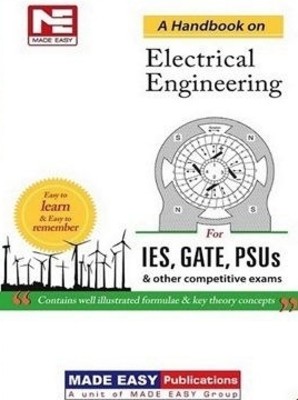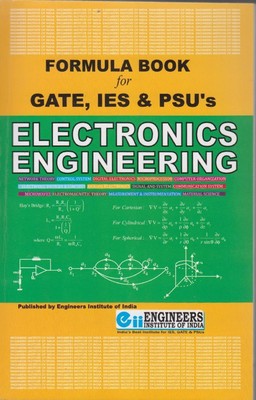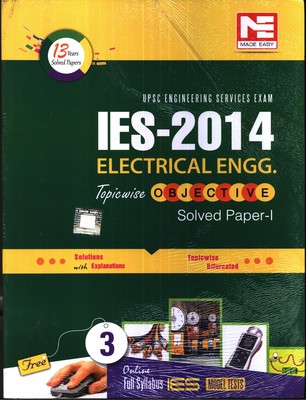|
#4
22nd March 2015, 11:28 AM
| |||
| |||
| Re: IES Guide Data
As you want I am here providing you material for Electrical Engineering students for IES exam. Electrical Engineering Syllabus for IES exam : Paper I 1. EM Theory Electric and magnetic fields. Gauss s Law and Amperes Law. Fields in dielectrics, conductors and magnetic materials. Maxwell s equations. Time varying fields. Plane-Wave propagating in dielectric and conducting media. Transmission lines. 2. ELECTRICAL MATERIALS Band Theory, Conductors, Semi-conductors and Insulators. Super-conductivity. Insulators for electrical and electronic applications. Magnetic materials. Ferro and ferri magnetism. Ceramics, Properties and applications. Hall effect and its applications. Special semi conductors. 3. ELECTRICAL CIRCUITS Circuits elements. Kirchoff s Laws. Mesh and nodal analysis. Network Theorems and applications. Natural response and forced response. Transient response and steady state response for arbitrary inputs. Properties of networks in terms of poles and zeros. Transfer function. Resonant circuits. Threephase circuits. Two-port networks. Elements of two-element network synthesis. 4. MEASUREMENTS AND INSTRUMENTATION Units and Standards. Error analysis, measurement of current, Voltage, power, Power-factor and energy. Indicating instruments. Measurement of resistance, inductance, Capacitance and frequency. Bridge measurements. Electronic measuring instruments. Digital Voltmeter and frequency counter. Transducers and their applications to the measurement of non-electrical quantities like temperature, pressure, flow-rate displacement, acceleration, noise level etc. Data acquisition systems. A/D and D/A converters. 5. CONTROL SYSTEMS Mathematical modeling of physical systems. Block diagrams and signal flow graphs and their reduction. Time domain and frequency domain analysis of linear dynamical system. Errors for different type of inputs and stability criteria for feedback systems. Stability analysis using Routh-Hurwitz array, Nyquist plot and Bode plot. Root locus and Nicols chart and the estimation of gain and phase margin. Basic concepts of compensator design. State variable matrix and its use in system modelling and design. Sampled data system and performance of such a system with the samples in the error channel. Stability of Sampled data system. Elements of non-linear control analysis. Control system components, electromechanical, hydraulic, pneumatic components. PAPER II 1. ELECTRCIAL MACHINES AND POWER TRANSFORMERS Magnetic Circuits – Analysis and Design of Power transformers. Construction and testing. Equivalent circuits. Losses and efficiency. Regulation. Auto-transformer, 3-phase transformer. Parallel operation. Basic concepts in rotating machines. EMF, torque, Basic machine types. Construction and operation, leakage losses and efficiency. B.C. Machines. Construction, Excitation methods. Circuit models. Armature reaction and commutation. Characteristics and performance analysis. Generators and motors. Starting and speed control. Testing, Losses and efficiency. Synchronous Machines. Construction. Circuit model. Operating characteristics and performance analysis. Synchronous reactance. Efficiency. Voltage regulation. Salient-pole machine, Parallel operation. Hunting. Short circuit transients. Induction Machines. Construction. Principle of operation. Rotating fields. Characteristics and performance analysis. Determination of circuit model. Circle diagram. Starting and speed control. Fractional KW motors. Single-phase synchronous and induction motors. 2. POWER SYSTEMS Types of Power Stations, Hydro, Thermal and Nuclear Stations. Pumped storage plants. Economics and operating factors. Power transmission lines. Modeling and performance characteristics. Voltage control. Load flow studies. Optimal power system operation. Load frequency control. Symmetrical short circuit analysis. ZBus formulation. Symmetrical Components. Per Unit representation. Fault analysis. Transient and steady-state stability of power systems. Equal area criterion. Power system Transients. Power system Protection Circuit breakers. Relays. HVDC transmission. 3. ANALOG AND DIGITAL ELECTRONICS AND CIRCUITS Semiconductor device physics, PN junctions and transistors, circuit models and parameters, FET, Zener, tunnel, Schottky, photo diodes and their applications, rectifier circuits, voltage regulators and multipliers, switching behavior of diodes and transistors. Small signal amplifiers, biasing circuits, frequency response and improvement, multistage amplifiers and feed-back amplifiers, D.C. amplifiers, Oscillators. Large signal amplifiers, coupling methods, push pull amplifiers, operational amplifiers, wave shaping circuits. Multivibrators and flip-flops and their applications. Digital logic gate families, universal gates-combination circuits for arithmetic and logic operational, sequential logic circuits. Counters, registers, RAM and ROMs. 4. MICROPROCESSORS Microprocessor architecture-Instruction set and simple assembly language programming. Interfacing for memory and I/O. Applications of Micro-processors in power system. 5. COMMUNICATION SYSTEMS Types of modulation; AM, FM and PM. Demodulators. Noise and bandwidth considerations. Digital communication systems. Pulse code modulation and demodulation. Elements of sound and vision broadcasting. Carrier communication. Frequency division and time division multiplexing, Telemetry system in power engineering. 6. POWER ELECTRONICS Power Semiconductor devices. Thyristor. Power transistor, GTOs and MOSFETS. Characteristics and operation. AC to DC Converters; 1-phase and 3-phase DC to DC Converters; AC regulators. Thyristor controlled reactors; switched capacitor networks. Inverters; single-phase and 3-phase. Pulse width modulation. Sinusoidal modulation with uniform sampling. Switched mode power supplies Books : IES, GATE, PSUs: A Handbook for Electrical Engineering (English) 1st Edition (Paperback) by Made Easy Publications  Electronics Engineering (Formula Book for GATE, IES & PSU's) (English) 1st Edition (Paperback) by R.K.Rajesh  IES 2014 Electrical Engineering Topicwise Objective Solved Paper - I by Made Easy  Last edited by Kiran Chandar; 22nd March 2015 at 11:31 AM. |